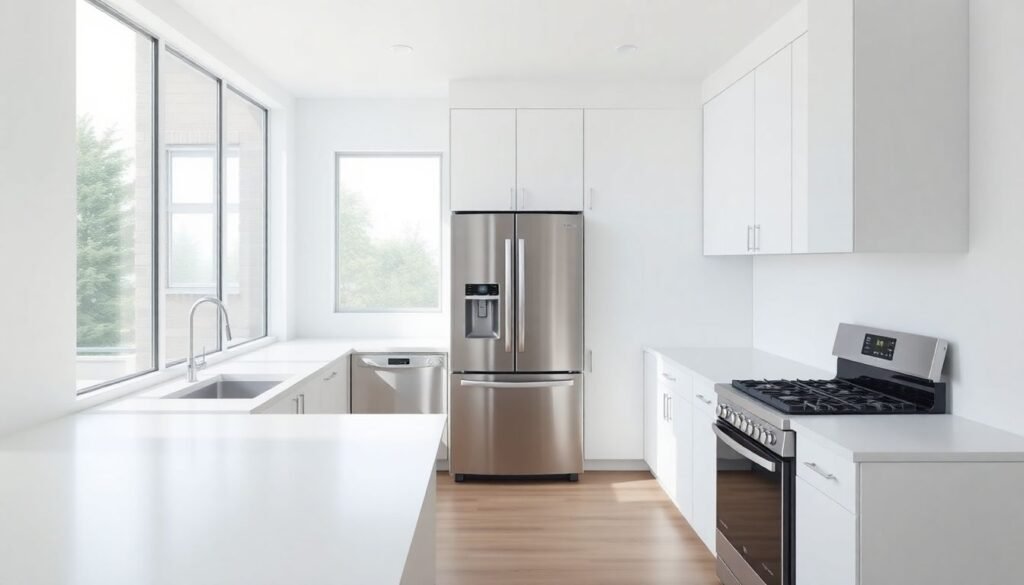
Energy-Efficiency Appliances In the U.S., households account for about 38% of total energy use, significantly impacting monthly budgets and the environment. As energy costs continue to rise, the need for cost-effective solutions becomes more critical. Energy-efficiency appliances are designed to reduce consumption while delivering the same performance.
This article will guide you through understanding energy-efficiency appliances, breaking down their benefits, categories, and practical tips for maximizing savings.
Understanding Energy Efficiency Ratings
Energy Star Certification Explained Energy Star is a program that identifies appliances meeting specific energy efficiency criteria. Products with this label use less energy without sacrificing quality or performance. When shopping, look for the Energy Star label on appliances to ensure you’re choosing an environmentally friendly option.
Deciphering Energy Labels
Energy labels provide insight into how much energy an appliance uses. Common ratings include:
SEER (Seasonal Energy Efficiency Ratio): Used for air conditioning units.
EER (Energy Efficiency Ratio): Its main function is to quantify how effectively a cooling unit converts electrical energy into cooling output. A higher EER indicates a more efficient system, meaning it provides more cooling per unit of energy consumed. This helps consumers compare different models and make informed decisions for efficient energy use, leading to cost savings and reduced environmental impact.
CEE (Consortium for Energy Efficiency): A rating for refrigerators and other appliances. For example, a refrigerator with a CEE Tier 2 rating consumes significantly less energy than one with a Tier 1 rating, leading to lower utility bills.
Energy-Efficiency Appliances The Cost-Savings Equation
Calculating potential savings is essential. For instance, switching from a standard refrigerator to an energy-efficient model could save you around $200 over its lifespan.
Use the manufacturer’s energy guide to find out annual operating costs and factor these into your budget. Refrigerators: Keeping it Cool and Green Choosing the Right Size Selecting an appropriately sized refrigerator is crucial.
An average fridge consumes around 400-600 kWh per year. Larger models may be convenient but often waste energy if not needed. Features to Look For Look for refrigerators with: Inverter compressors:
Adjust cooling based on requirements.
LED lighting: More efficient than traditional bulbs. Efficient insulation:
Reduces temperature loss. Models like the Samsung Family Hub offer both efficiency and functionality.
Maintaining Your Refrigerator for Optimal Efficiency To maximize savings: Keep the fridge at the recommended temperature (35-38°F). Washing Machines & Dryers: Laundry Day, Eco-Friendly Way High-Efficiency (HE) Models HE washers and dryers use less water and energy.
Washers remove more water during the spin cycle, which shortens drying time.This leads to lower utility costs over time. Water and Energy Consumption Comparisons HE washers use about 25% less energy than standard models. For instance, an HE washer may consume 30% less water than a traditional one.
Eco-Friendly Detergents and Practices Use environmentally friendly detergents and fill the washer to full capacity. This minimizes both water and energy consumption. Dishwashers: Clean Dishes, Clean Conscience Energy Star Certified Dishwashers Energy Star dishwashers have advanced technology to minimize water and energy usage.
Features like soil sensors optimize water use based on cleanliness levels. Water and Energy Consumption High-efficiency models often use half the water and energy compared to standard dishwashers.
A typical Energy Star model consumes about 3.5 gallons per load, while older models consume around 10 gallons. Optimizing Dishwasher Usage Run your dishwasher with full loads only. Use the air-dry feature instead of heated drying for further savings.
Other Energy-Efficiency Appliances HVAC Systems Regular maintenance on HVAC systems keeps them running efficiently.
Energy-efficiency models can save up to 20% more energy. An HVAC expert says, “Small tune-ups can lead to big savings.” Lighting Switching to LED lighting drastically reduces energy use. LEDs use up to 75% less energy than traditional bulbs and last much longer.
They help reduce “phantom” energy use, saving you even more on your energy bills.
Investing in energy-efficiency appliances is a smart move for your wallet and the environment.
Conclusion:
Key takeaways include understanding energy ratings, choosing the right size, and utilizing features designed for efficiency. By doing research and making informed purchases, you can reduce monthly energy bills and contribute to a healthier planet. Start exploring energy-efficient options today and make a positive change for your home and the environment.